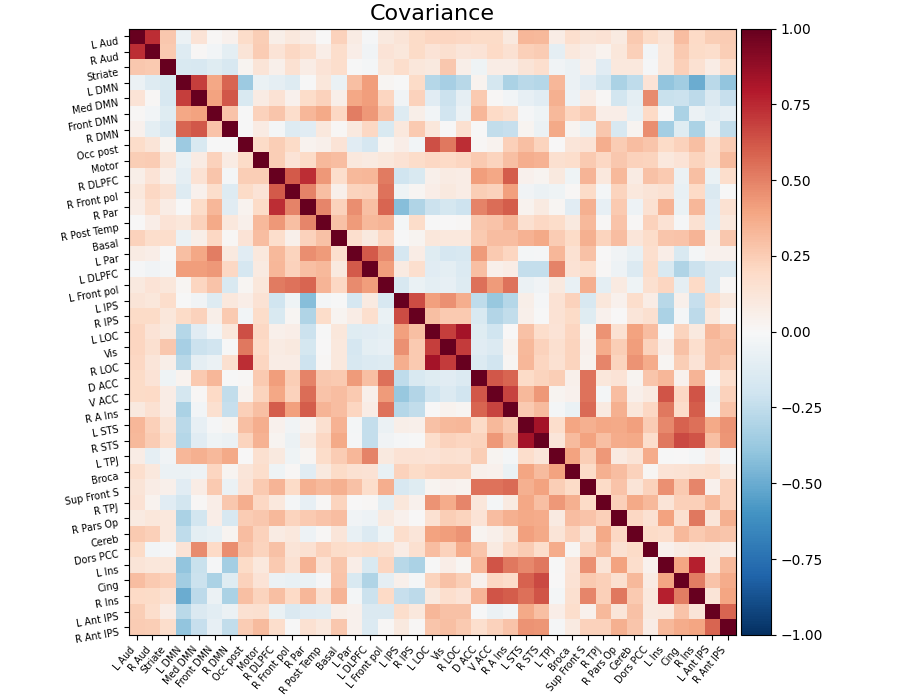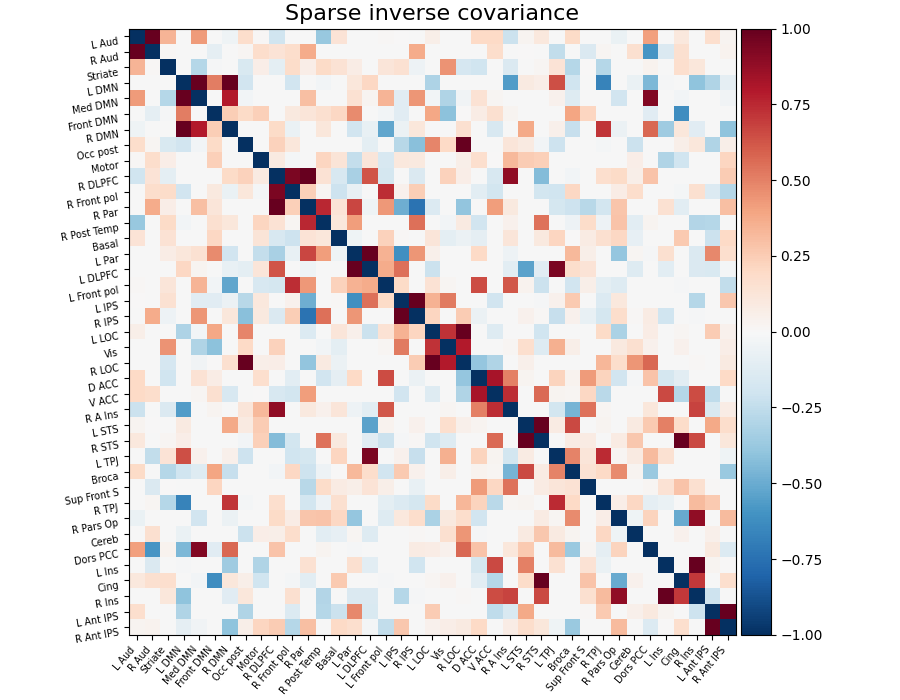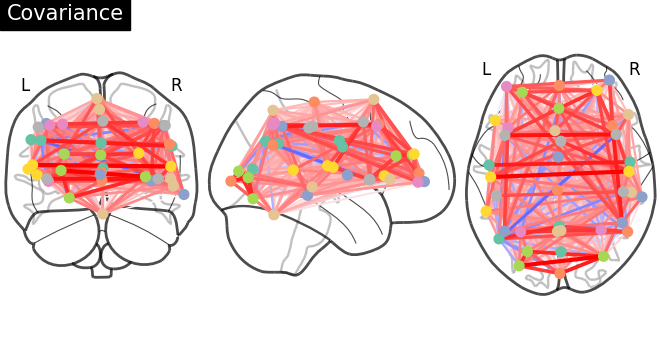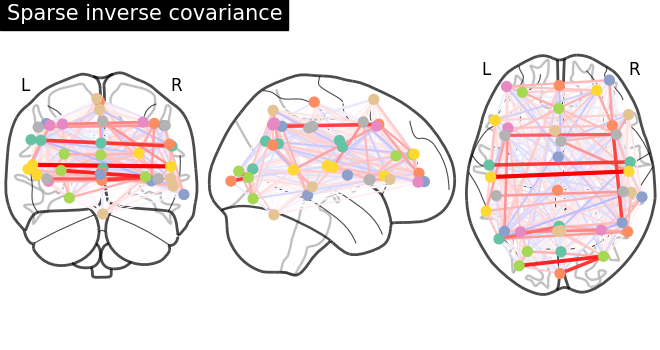6.2. Connectome extraction: inverse covariance for direct connections¶
6.2.1. Sparse inverse covariance for functional connectomes¶
Functional connectivity can be obtained by estimating a covariance (or correlation) matrix for signals from different brain regions decomposed, for example on resting-state or naturalistic-stimuli datasets. The same information can be represented as a weighted graph, vertices being brain regions, weights on edges being covariances (gaussian graphical model). However, coefficients in a covariance matrix reflect direct as well as indirect connections. Covariance matrices form very dense brain connectomes, and it is rather difficult to extract from them only the direct connections between two regions.
As shown in Smith et al.[1], Varoquaux et al.[3], it is more interesting to use the inverse covariance matrix, ie the precision matrix. It gives only direct connections between regions, as it contains partial covariances, which are covariances between two regions conditioned on all the others.
To recover well the interaction structure, a sparse inverse covariance
estimator is necessary. The GraphicalLasso, implemented in scikit-learn’s
estimator sklearn.covariance.GraphicalLassoCV is a good, simple
solution. To use it, you need to create an estimator object:
from sklearn.covariance import GraphicalLassoCV
estimator = GraphicalLassoCV()
And then you can fit it on the activation time series, for instance extracted in the previous section:
estimator.fit(time_series)
The covariance matrix and inverse-covariance matrix (precision matrix)
can be found respectively in the covariance_ and precision_ attribute
of the estimator:
estimator.covariance_
estimator.precision_
6.2.2. Sparse inverse covariance on multiple subjects¶
To work at the level of a group of subject, it can be interesting to estimate multiple connectomes for each, with a similar structure but differing connection values across subjects.
For this, nilearn provides the
nilearn.connectome.GroupSparseCovarianceCV
estimator. Its usage is similar to the GraphicalLassoCV object, but it takes
a list of time series:
estimator.fit([time_series_1, time_series_2, ...])
And it provides one estimated covariance and inverse-covariance (precision) matrix per time-series: for the first one:
estimator.covariances_[0]
estimator.precisions_[0]
One specific case where this may be interesting is for group analysis across multiple subjects. Indeed, one challenge when doing statistics on the coefficients of a connectivity matrix is that the number of coefficients to compare grows quickly with the number of regions, and as a result correcting for multiple comparisons takes a heavy toll on statistical power.
In such a situation, you can use the GroupSparseCovariance and
set an alpha value a bit higher than the alpha value selected by
cross-validation in the GroupSparseCovarianceCV. Such a choice
will enforce a stronger sparsity on the precision matrices for each
subject. As the sparsity is common to each subject, you can then do the
group analysis only on the non zero coefficients.
6.2.3. Comparing the different approaches on simulated data¶
We simulate several sets of signals, one set representing one subject, with different precision matrices, but sharing a common sparsity pattern: 10 brain regions, for 20 subjects.
A single-subject estimation can be performed using the
sklearn.covariance.GraphicalLassoCV estimator from scikit-learn.
It is also possible to fit a graph lasso on data from every subject all together.
Finally, we use the
nilearn.connectome.GroupSparseCovarianceCV [5].
The results are the following:
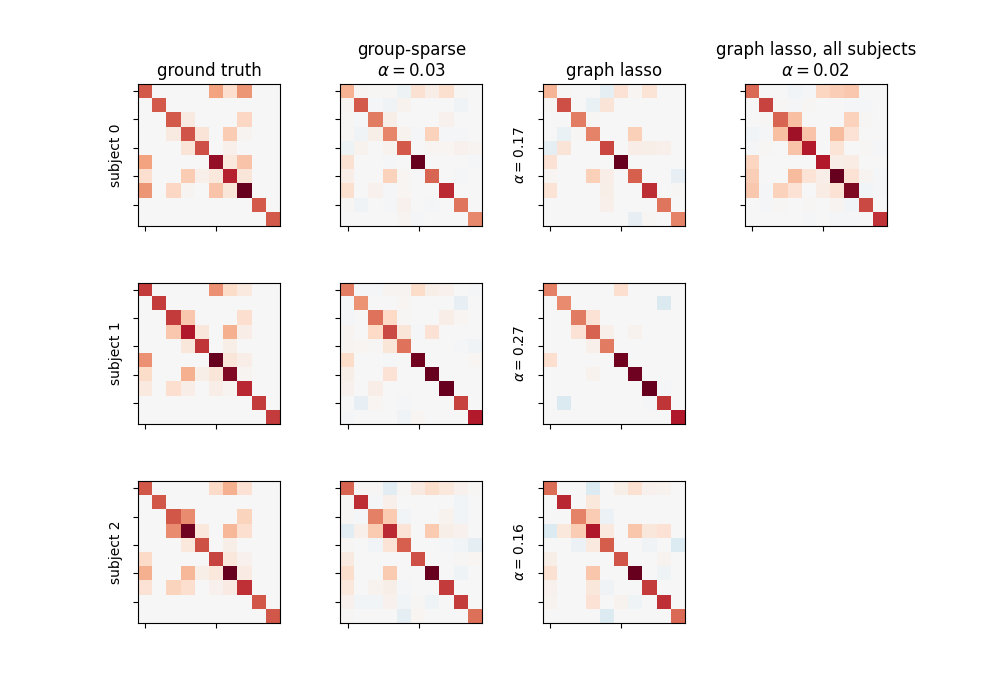
The group-sparse estimation outputs matrices with the same sparsity pattern, but different values for the non-zero coefficients. This is not the case for the graph lasso output, which all have similar but different structures. Note that the graph lasso applied to all subjects at once gives a sparsity pattern close to that obtained with the group-sparse one, but cannot provide per-subject information.
Reference
The Brain covariance selection: Better individual functional connectivity models using population prior [3]
6.2.4. Linking total and direct interactions at the group level¶
Individual connectivity patterns reflect both on covariances and inverse covariances, but in different ways. For multiple subjects, mean covariance (or correlation) and group sparse inverse covariance provide different insights into the connectivity at the group level.
We can go one step further by coupling the information from total (pairwise) and direct interactions in a unique group connectome. This can be done through a geometrical framework allowing to measure interactions in a common space called tangent space [Varoquaux et al, MICCAI 2010].
In nilearn, this is implemented in
nilearn.connectome.ConnectivityMeasure:
measure = ConnectivityMeasure(kind='tangent')
The group connectivity is computed using all the subjects timeseries.:
connectivities = measure.fit([time_series_1, time_series_2, ...])
group_connectivity = measure.mean_
Deviations from this mean in the tangent space are provided in the connectivities array and can be used to compare different groups/runs. In practice, the tangent measure can outperform the correlation and partial correlation measures, especially for noisy or heterogeneous data.
Full example
See the following example for a full file running the analysis: Classification of age groups using functional connectivity
Exercise: computing connectivity in tangent space
Compute and visualize the tangent group connectome based on the brain
development
dataset downloaded with nilearn.datasets.fetch_development_fmri
Hints: The example above has the solution
Reference
Detection of brain functional-connectivity difference in post-stroke patients using group-level covariance modeling} [6]
6.2.4.1. References¶
Stephen M. Smith, Karla L. Miller, Gholamreza Salimi-Khorshidi, Matthew Webster, Christian F. Beckmann, Thomas E. Nichols, Joseph D. Ramsey, and Mark W. Woolrich. Network modelling methods for FMRI. NeuroImage, 54(2):875–891, January 2011. doi:10.1016/j.neuroimage.2010.08.063.
Gaël Varoquaux and R. Cameron Craddock. Learning and comparing functional connectomes across subjects. NeuroImage, 80:405–415, 2013. Mapping the Connectome. doi:10.1016/j.neuroimage.2013.04.007.
Gael Varoquaux, Alexandre Gramfort, Jean Baptiste Poline, and Bertrand Thirion. Brain covariance selection: better individual functional connectivity models using population prior. Advances in neural information processing systems, 2010. URL: https://inria.hal.science/inria-00512451, arXiv:1008.5071.
J. Friedman, T. Hastie, and R. Tibshirani. Sparse inverse covariance estimation with the graphical lasso. Biostatistics, 9(3):432–441, July 2008. doi:10.1093/biostatistics/kxm045.
Gael Varoquaux, Flore Baronnet, Andreas Kleinschmidt, Pierre Fillard, and Bertrand Thirion. Detection of brain functional-connectivity difference in post-stroke patients using group-level covariance modeling. In Tianzi Jiang, Nassir Navab, Josien P. W. Pluim, and Max A. Viergever, editors, Medical image computing and computer-assisted intervention - MICCAI 2010, Lecture notes in computer science, 200–208. Berlin, Heidelberg, 2010. Springer. doi:10/cn2h9c.
